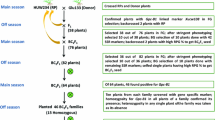Summary
Hybridization followed by continuous selection of lines of barley from different cross-combinations involving high protein-high lysine genotypes and the agronomically superior strains resulted in breaking the negative correlations between 1000 grain weight and high protein content and high DBC values. The methodology of DBC-Kjeldahl protein adopted in the present study is likely to be useful in identifying high lysine lines. The present study has shown considerable variability with respect to protein content and grain weight and has provided interesting genotypes which can be used in synthesising lines with improved nutritional quality and productivity in barley. The success in breaking the undesirable linkages to factors that impair the endosperm development is due to sufficient genetic variability in the initial breeding material as well as the use of suitable breeding procedures like the full-sib mating in the early segregating generations.
Similar content being viewed by others
Literature
Bansal, H.C. (1970): A new mutant induced in barley. Curr. Sci. 39, 494
Bansal, H.C. (1974): Induced variability for protein quantity and quality in barley. Indian J. Genet. 34 A, 657–661
Bansal, H.C.; Bhaskaran, S. (1976): Attempts at combining the yield and protein quality in barley. Barley Genet. Newsl. 6, 6–7
Bansal, H.C; Srivastava, K.N.; Eggum, B.O.; Mehta, S.L. (1977): Nutritional evaluation of high protein genotypes of barley. J. Sci. Food. Agri. 28, 157–160
Barabacki, S. (1974): Further studies on inheritance and variability of nitrogen content in the grain of barley. Rocz. Nauk Roln. 49, 267–315
Bhatia, C.R.; Rabson, R. (1976): Bioenergetic considerations in cereal breeding for protein improvement. Science 194, 1418–1421
Bhatia, C.R.; Desai, R.M.; Suseelan, K.N. (1978): Attempts to combine high yield and increased grain protein in wheat. In: Seed Protein Improvement by Nuclear Techniques, pp. 51–57. Vienna: IAEA
Doll, H. Koie, B.; Eggum, B.O. (1974): Induced high lysine mutants in barley. Radiation Bot. 14, 73–80
Doll, H.; Koie, B. (1978): Influence of the high-lysine gene from barley mutant 1508 on grain, carbohydrate and protein yield. In: Seed Protein Improvement by Nuclear Techniques, p. 107–114. Vienna: IAEA
Favret, E.A.; Mangers, L; Solari, R.; Avila, A.; Monesiglio, J.C. (1970): Gene control of protein production in cereal seeds. In: Improving Plant Protein by Nuclear Techniques, pp. 87–97. Vienna: IAEA
Hagberg, A.; Karlsson, K.E. (1969): Breeding for high protein content and quality in barley. In: New Approaches to Breeding for Improved Plant Protein, pp. 17–21. Vienna: IAEA
Hoffman, W. (1950): Futtergerstenzüchtung. In: Hb. Pflanzenzücht. Bd. 2, pp. 209–217. Hamburg: Berlin, Parey
Johnson, V.A.; Mattern, P.J.; Wilhelmi, K.D., Kuhr, S.L. (1978): Seed protein improvement in common Wheat (Triticum aestivum L.): oppotunities and constraints. In: Seed Protein Improvement by Nuclear Techniques, pp. 23–32. Vienna: IAEA
Mertz, E.T.; Bates, L.S.; Nelson, O.E. (1964): Mutant gene that changes protein composition and increases lysine content of maize endosperm. Science 145, 279–280
Mossberg, R. (1969): Evaluation of protein quality and quantity by dye-binding capacity: a tool in plant breeding. In: New Approaches to Breeding for Improved Plant Protein, pp. 151–160. Vienna: IAEA
Munck, L. (1972): Improvement of nutritional value in cereals. Hereditas 72, 1–128
Munck, L.; Karlsson, K.E.; Hagberg, A. (1969): Selection and characterization of a high-protein, high-lysine variety from the World Barley Collection. Proc. 2nd Int. Barley Genet. Symp., pp. 544–558
Nelson, O.E. (1969): The modification by mutation of protein quality in maize. In: New Approaches to breeding for Improved Plant Protein, pp. 41–54 Vienna: IAEA
Singh, R.; Axtell, J.D. (1973): High lysine mutant gene (hl) that improves protein quality and biological value of grain sorghum. Crop Sci. 13, 535–539
Singhal, N.C.; Jain, H.K.; Austin, A. (1978): Induced variability for protein content in bread wheat. In: Seed Protein Improvement by Nuclear Techniques, pp. 41–50. Vienna: IAEA
Viuf, B.T. (1972): Varietal differences in nitrogen content and protein quality in barley. Kgl. Vet. og. Landbohojsk. Arsskr. 37–61
Welsh, R.W. (1978): Evaluation of high-lysine and high-protein barley genotypes. Cereal Res. Comm. 6, 393–398
Author information
Authors and Affiliations
Additional information
Communicated by H.F. Linskens
Rights and permissions
About this article
Cite this article
Bansal, H.C., Singh, R.P., Bhaskaran, S. et al. Hybridization and selection for improving seed protein in barley. Theoret. Appl. Genetics 58, 129–136 (1980). https://doi.org/10.1007/BF00263104
Received:
Issue Date:
DOI: https://doi.org/10.1007/BF00263104




